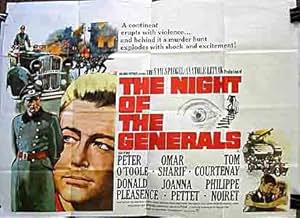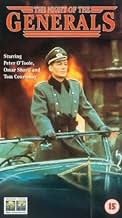Eine polnische Prostituierte und deutsche Agentin wird in Warschau ermordet. Der Verdacht fällt auf drei Generäle, und Major Grau vom deutschen Geheimdienst bemüht sich um Gerechtigkeit, was... Alles lesenEine polnische Prostituierte und deutsche Agentin wird in Warschau ermordet. Der Verdacht fällt auf drei Generäle, und Major Grau vom deutschen Geheimdienst bemüht sich um Gerechtigkeit, was Jahrzehnte dauern wird.Eine polnische Prostituierte und deutsche Agentin wird in Warschau ermordet. Der Verdacht fällt auf drei Generäle, und Major Grau vom deutschen Geheimdienst bemüht sich um Gerechtigkeit, was Jahrzehnte dauern wird.
- Auszeichnungen
- 1 wins total
- Juliette
- (as Juliette Greco)
- Doctor
- (as Sacha Pitoeff)
- Colonel (War Room)
- (as Raymond Gerome)
Empfohlene Bewertungen
The film is brimming with exceptional acting - O'Toole turns in a particularly vicious and strong performance as General Tanz, but everyone holds their own. It's rare to find a villain so distasteful and yet so intriguing - most filmmakers just content themselves with giving the villain an evil shtick without much character development - not so here.
I saw a newly mastered DVD in full 2.35:1 widescreen presentation and the the cinematography by the late Henri Decae is wonderful in all its glory.
Very interesting movie, please see it.
This terrifying and sinister story turns out to be a big budgeted whodunit set in Nazi-occupied Poland and Paris full of big stars , thrills , emotions and too tense at times. Peter O'Toole and Omar Sharif give terrific performances as maniac general and upright investigator respectively . Tom Courtenay gives the best acting as a disillusioned German Corporal and Philipe Noiret is top-notch as Police Inspector who works for both sides. The splendid cast includes Joanna Pettet who contributes the most controlled interpretation , John Gregson , Coral Browne, Gordon Jackson and the French singer-actress Juliette Greco singing a wonderful song . The best scenes result to be when general O'Toole is watching paintings have been selected and requisitioned from private collections by the Reichsmarshall Herrmann Goering , then he observes the ¨Decadent Art¨ as Touloise Lautrec (Le Divan) , Renoir (Nudes), Gauguin (On the beach) Soutine, Degas (The tub) and Vincent Van Gogh (self-portrait ) , when he suddenly bursts on real crazy.
Well adapted for the screen by Joseph Kessel from the best-seller novel by Hellmut Kirst with additional dialogue by Paul Dehn -Planet of Apes- and based on an incident written by James Hadly Chase. . Marvelous musical score by Maurice Jarre conducting the New-Philharmonic Orchestra-London . Excellent title sequence and spectacular production designed by Alexandre Trauner . Finely photographed on location in Poland and at studios De Boulogne-Paris . Glamorous and glimmer cinematography in Technicolor by extraordinary cameraman Henry Decae . This dark motion picture of epic proportions is stunningly produced (along with Sam Spiegel) and realized by Anatole Litvak (Snake pit , Sorry wrong number , Mayerling , Anastasia). This steam-roller based partially on fact has a high-rating : Better than average , though may be little slow for some tastes. Well worth watching .
Having been aware of this film for many years, I finally managed to catch a rare screening of it last night on British TV. Part of my curiosity to see it was due to the sheer weight of the cast:- Omar Sharif as Major Grau, Peter O'Toole, Donald Pleasence and Charles Gray as the Generals, plus Christopher Plummer, Tom Courtenay, Philip Noiret, Gordon Jackson, John Gregson, Harry Andrews, Nigel Stock and Patrick Allen - phew! The film itself starts quite promisingly as a murder mystery and maintains the interest while based in Warsaw. It features an impressive sequence involving the flushing out of Polish Resistance fighters in the city. An interesting side-note at this point is that the armour used here appeared to be either real Tiger tanks, or pretty good replicas. This attention to detail was quite unusual for a film made in 1966. Usually, contemporary armour was used in war films of this vintage - I'm thinking particularly of 'Battle Of The Bulge', 'The Bridge At Remagen' and even 'Patton'.
However, once the scene shifts to Paris in the summer of 1944, the film starts to lose focus, meandering off on sub-plots about the Hitler assassination conspiracy and Tom Courtenay's character's love life. For long stretches Omar Sharif disappears altogether and the momentum is lost. Another distraction is the way the film jumps forward at intervals to the '60's, where we find Philip Noiret's Policeman interviewing some of the secondary characters in an attempt to solve the mystery. But by this point the killer's identity has become all too clear.
The film is by no means a total waste. It is in part an interesting study of German senior officers. The acting is good throughout, and to see stalwarts of British war films like Harry Andrews and John Gregson playing Germans is both curious and original. The script is literate, production design handsome, and the 1.78:1 presentation on ITV3 gave a tantalising glimpse of how good Henri Decae's photography would look in it's full 2.35:1 Panavision frame. But overall I was left feeling that with tighter handling regarding the killer's identity, and more emphasis on the central plot, the film could have been a far more satisfying whole.
Wusstest du schon
- WissenswertesBecause Peter O'Toole and Omar Sharif were being held to contracts signed several years earlier, when they were less famous, they both had to accept smaller fees than one would expect, given how famous they were when this movie was made early in 1966. Neither was very happy with this situation, but they took care to claim the lavish living expenses to which they were entitled.
- PatzerMajor Grau is handed a German soldier's identity disc from the crime scene in Paris shortly before Operation Valkyrie commences. He reveals the name of the suspect by apparently reading the name on the disc. German identity discs, however, never contained the soldier's name on them - only their roll number, unit designation and occasionally their blood group.
- Zitate
Major Grau: One of them is a... a murderer.
Inspector Morand: Only one? But murder is the occupation of Generals.
Major Grau: Then let us say what is admirable on the large scale is monstrous on the small. Since we must give medals to mass murderers, why not give justice to the small... entrepreneurs.
- Crazy CreditsThe opening titles are a montage of a Nazi general's clothing and decorations.
- Alternative VersionenThe UK cinema version was heavily edited for an 'A' (PG) certificate and removed nearly all the references to the victims being whores, as well as shortening the bed scene between Hartmann & Ulrike, the police interrogation of the suspected sex offenders, and editing some of the dialogue describing the murders. Later releases were upgraded to a 15 certificate and were fully uncut.
- VerbindungenFeatured in Discovering Film: Omar Sharif (2015)
Top-Auswahl
- How long is The Night of the Generals?Powered by Alexa
Details
- Erscheinungsdatum
- Herkunftsländer
- Sprachen
- Auch bekannt als
- The Night of the Generals
- Drehorte
- Mostowa, New Town, Sródmiescie, Warschau, Masowien, Polen(shootout with Polish resistance)
- Produktionsfirmen
- Weitere beteiligte Unternehmen bei IMDbPro anzeigen
- Laufzeit
- 2 Std. 28 Min.(148 min)
- Seitenverhältnis
- 2.35 : 1






































